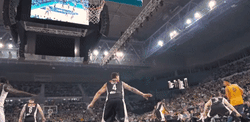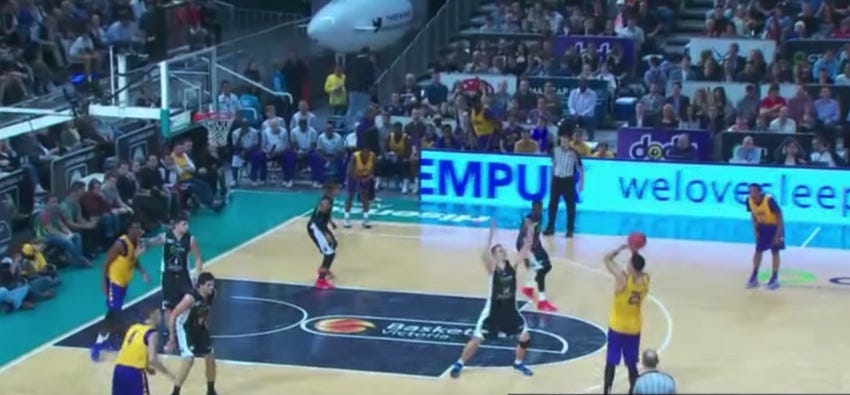Ben Simmons: The United Lockdown
An exhibition game against a pro team that will likely be forgotten in the footnotes of Simmons' basketball career - did it offer any clues on the future?
Limitless potential.
This could very well be the tagline for Ben Simmons, Australia’s most exciting basketball prospect on the horizon.
Simmons, who played in front of an enthusiastic Melbourne home crowd of 8,646 last weekend, recorded a quiet 16 points, 11 rebounds and 3 assists in an 82-64 loss to Melbourne United. It was a case of United squaring things up against a tired road team, sweet revenge for LSU's earlier 97-89 victory.
Did the game however, present hints of Simmons’ challenges in the college season ahead?
What exactly is Ben Simmons?
The LSU freshman is tailored for the NBA’s latest fad, a trend exemplified by last season's champions, the Golden State Warriors. Part of the Warriors’s devastating success came from their ability to feature multiple swingmen together; versatile, rangy athletes who could switch and defend at will. Ben Simmons’ potential however, goes beyond defensive versatility alone.
He is the complete package - a virtuoso that plays five positions with equal ease, on offence and defence.
Unlike Boomers teammate Dante Exum, a guard who moves with a smooth, almost liquid grace, Simmons’ broader physique exudes an aura of studied intensity. He plays basketball with a nod to the physicality that comes with the game; he punishes smaller defenders on the block, and drives at the rim with purpose, striving to finish through contact.
Simmons prefers to call himself a point forward, a label that has been used on Celtics legend Larry Bird, and more recently? A certain LeBron Raymone James. King James, likely the best player in the league right now, who plays power forward with the unmatched passing vision of an elite playmaker.
Surely a coincidence, that James is Simmons’ favourite player? Not.
The possibilities Simmons presents
Saturday night. The game had barely begun, but Ben Simmons’ jersey was visibly soaked. Had fatigue from the earlier games caught up? Perhaps, but it was too early to tell.
Simmons dribbled towards the United defence, moving at an easy, loping gait, and challenged his defender to focus on the task at hand. The youthful freshman looms head and shoulders over most guards, and tonight was no exception. Simmons wasn’t just LSU's point guard however; he was their point forward.
Pick and roll? One quick crossover had Simmons surging past Majok Majok, driving into the paint, right at centre Chris Patton.
Action, reaction. Force the defence to react, and you will find opportunities to exploit.
Patton had barely committed to the defensive rotation, but Simmons was already moving on to the next course of action. The lanky freshman leaped towards an outstretched Patton, and dropped the ball off to an undefended Aaron Epps without a moment's hesitation.
Posting up? Simmons anchored himself down low on multiple occasions, calling for the ball with authority.
Distract, disrupt. Draw attention towards yourself, and openings will show.
The United defenders had to be wary. A tentative step or two away from their assigned targets, and that was all it took for Simmons to find those moments of indecision, to rifle passes to the open teammate.
Defence? Much like his prior game against Melbourne United at Dandenong, Simmons slid into the paint and defended centres with unnerving ease. He held ground against big men, denied passing lanes, and even functioned as a rim protector, recording three blocks that night.
How does one fit a versatile piece like Simmons on the floor?
Much like the concept of yin and yang, Simmons’ ability to morph into different roles, requires similar adaptability from the team to form a unified whole. The guards have to be effective when Simmons handles the ball. The big men need to share space in the paint with Simmons, and be ready to work in other roles; as opportunistic rebounders (think Tristan Thompson), as shooters (Pau Gasol), or even screeners, to provide secondary action and allow shooters to get free.
The lockdown
A preseason exhibition tour provides few, if any hints on Ben Simmons’ first college season. That being said, it felt like LSU had yet to figure out how to best optimise Simmons’ impact on the court.
Melbourne United’s focus that night, was to isolate Simmons and leave him in a vacuum. United had two players on Simmons on most screen and roll plays. They ignored the screener and clamped on Simmons, denying the space he needed to facilitate the offence.
The pressure continued, even when Simmons was establishing post position. Simmons’ defender would front him in an attempt to deny the entry pass, while other United players lay in wait. Simmons clocked six turnovers that night, some of which were forced passes that got picked off; others were attempts to make plays that just were not there.
Taking passing lanes away were part of the plan; another aspect involved encouraging Simmons to not pass, and that included a calculated gamble on Simmons’ shooting. Surrender space to shoot, but not driving lanes. It paid off somewhat - Simmons made only two shots from downtown.
In this possession, notice the distance between Simmons and his defender, Daniel Kickert.
There's no way Kickert could have sent a clearer invitation for Simmons to take the shot.
The resulting miss became a fast break led by Stephen Holt, who found fellow guard Todd Blanchfield for a layup that unfortunately, also drew a whistle for the and one.
It's too easy to overlook the six-point swing that occurred within fifteen seconds. LSU lost three points from Simmons’ missed attempt and surrendered another two, possibly even three points to United.
Simmons also admitted after the game, that fatigue had affected his performance. “Physically, I was tired. My legs were kind of shot. We were supposed to be ready. Mentally I was supposed to be ready, but I wasn't.”
Execution and hustle
There were obviously other reasons for United’s victory. The team displayed excellent chemistry, swinging the ball methodically to tear LSU’s defence apart. LSU coach, Johnny Jones spoke about United’s offence post-game, admitting the home team performed better that night.
“I thought they did a much better job of executing on both ends of the floor. Offensively, they were clicking. They were the aggressor when they came out, and I thought they played with a much greater level of intensity in the first half. We didn’t match their intensity level.
“They did an excellent job of rebounding and second-chance opportunities. We did not do that, and that gave us a little bit of a separation.”
Coach Jones might have been talking about United’s latest import, Stephen Holt. The first thing one would notice, is that Holt has a persistent, restless way of looking at things. He would shift focus constantly, casting his eyes about. He would take in everything without pause, ready to make a move. That was seemingly his modus operandi on the court. He would score, rebound, and make plays, even the ones that did not show up on the box score. He scrambled after loose balls, and turned uncertain situations into positive plays.
This game is but a blip in the grand scheme of things, a brief homecoming that will be forgotten.
Did Melbourne United perhaps, deliver an important lesson that night? They showed a fatigued, young college team just how vulnerable their budding star could be, when isolated from the pack.
“We played a very experienced team [Saturday]. We played a lot games in a short amount of days and when you play a team like this, it makes it difficult. We were exposed, but I'm really pleased with the effort of the guys during the time we were here and there are certainly some things that we look forward to working on when we get home.”
One thing's certain: Jones is focused on making things better. Not just for Simmons, but for his team in the days ahead.
*Statistics from box score. Video credits to Downtown Australia. GIF extracted from video taken by Samuel Kwong.




